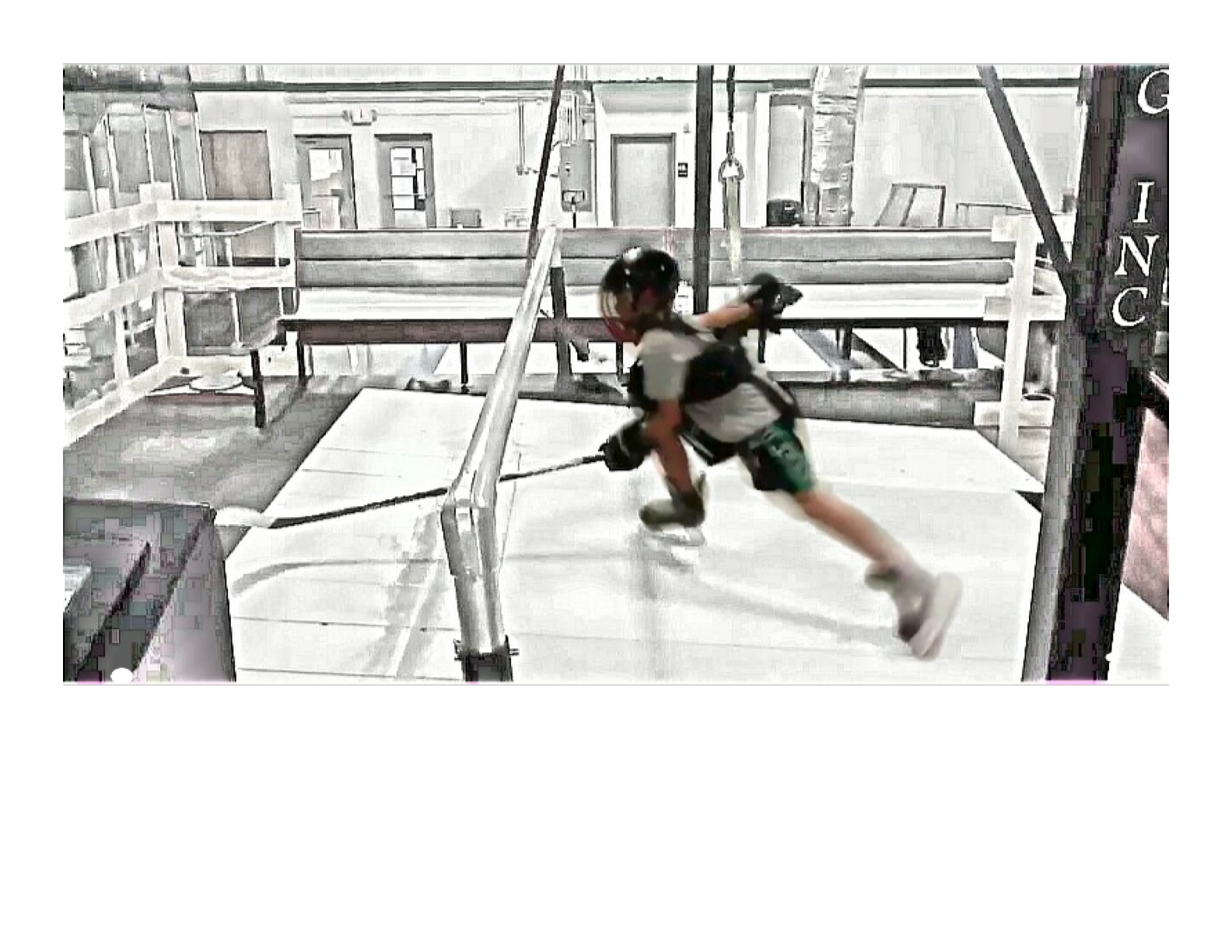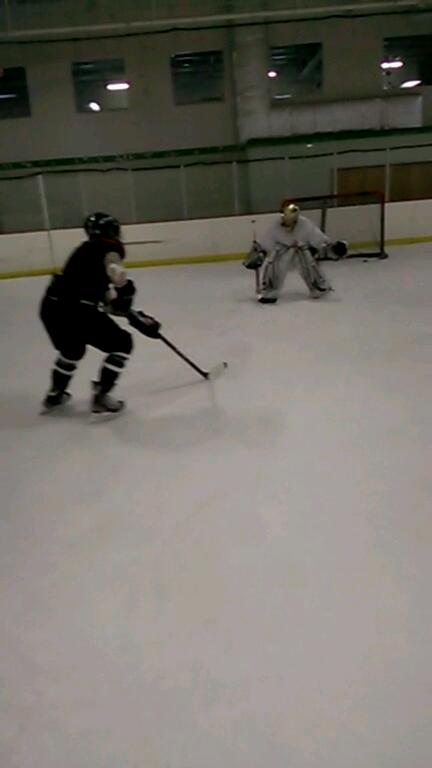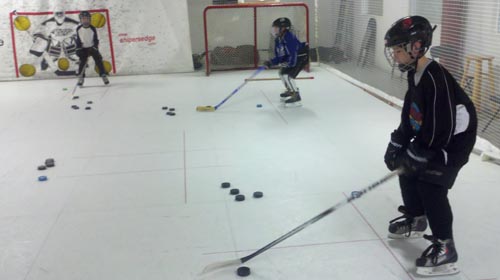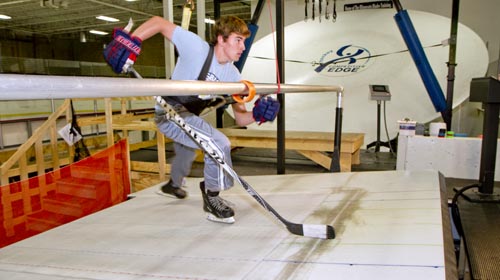General Information for Instructors

We want our instructors to be able to focus on the job of getting players better at Hockey as rapidly as possible, but there are many things that you need to know which are peripheral to that job itself. On the other hand, some of the stuff here does apply pretty directly to the instructing task. Anyway, below, we cover some safety considerations, opening and closing, dealing with customers and more.
Safety
As stated above we want our instructors to focus as much as possible on helping kids get better at hockey during their session, but one thing must be eliminated as a consideration before that can be the case. Until safety is assured it is the only thing we should be worried about. This means…
- Making sure harnesses are put-on correctly
- Making sure skaters are properly attached to the “safety lines” that keep them on the treadmill
- Making sure any time a skater is on a running treadmill our hand is in range to quickly hit the emergency stop button
- Player behavior is good and is not putting any body in danger
- We are keeping an eye on the environment so as to anticipate any other problems that might arise
Once we can be sure about all of this, we then should be as close as possible to 100% engaged in providing the instruction and training that will get players better at a maximum rate.
Training Sessions Format
Our standard session includes 30 minutes at each of three two stations. The three two stations are…
The Crossover Flywheel- The Bullet Treadmill
- Our Hand Skills Area
Training on the Wheel and Treadmill are one-skater-at-a-time and filling 30 minutes is simply a matter of getting each player as many skates as possible which are relevant to their skill level (relevance to their skill level is determined by considering that more advanced skaters can do more advanced sorts of training on the wheel and treadmill – bursts, puckhandling, etc. – as long as the quality of their stride is maintained during the advanced training).
In the Hand Skills Area, we need to fill the time for the whole group so it requires some thought to make sure we have relevant drills to do that which also get players a lot of reps. In terms of planning a session, the Hand Skills Area requires the most work (although, when instructors are comfortable with the drills we use and the details we are trying to bring out within those drills, most planning happens on the fly during sessions by simply drawing from a toolbox of drills and details).
The above format applies to most small group sessions as well as team sessions, however custom sessions are a part of our offering so there will be times where you’ll spend differing amounts of time at each station.

Philosophy of Training
We are different from other Hockey training centers in that we feature a focus on technique over strength and conditioning with respect to Skating Treadmill training. With both the Crossover Flywheel and Skating Treadmill, you are welcome to push kids to high exertion levels only if they are able to perform correct technique at those levels. On the skating treadmill, even with not-so-great skaters, getting proper extension often requires training close to high exertion levels… just not all the way at high exertion levels (until they are well adapted to the treadmill). Correct technique means maintaining all key technique components including deep knee bend, great extension, good posture, good push direction, and good smoothness to the stride.
Players who can best manage their physical and mental systems during the game will thrive. Doing more stuff at once and more quickly is a critical advantage in the game and ultimately separates players more than any other skill aspect, in our opinion. For this reason we want to train players to multitask. Again, we are promoting great technique and we need to make this our first focus. However, as long as we are confident that their technique is improving, we should be getting players to multitask within our training a good amount.
Players who are having fun will put all of their mental energy into training. Fun is a great thing for its own sake, but it also makes the training better. Find ways to ensure the training is fun. This won’t work for all kids as some will just not like the training, but we should always make the attempt.
This again requires players to do their part first, so it is ok to take away a more fun component of the training if players haven’t “earned” it. You should mention this requirement for them to “earn” their fun toward the beginning of a session to make sure players understand how you are operating.
Any games that we can come up with that also features instruction and lots of quality reps are a great way to hit all of our goals listed above. Don’t hesitate to use games to help kids work toward great technique. One thing we have to be careful of with games though is that sometimes they lead to reduced reps. Try to set them up so they keep reps high.
A general process for getting across the detailed nature of a skill can be the following sequence:
- Tell
- Show
- Observe
- Give feedback (what is right and wrong and how to fix what is wrong… which means basically go back to #1, “Tell”)
- Repeat until they have a refined understanding or, in a rare case, a refined correct technique
Judgement must be used with this as we want to ensure reps stay and and its fun, so we can’t insist on too much progress of either understanding or actually technique refinement in any session or even 5 minute increment of a session. So, we want to use 1 through 5 above, but with controlled expectations on how far a kid can be expected to make it in one day and on how much appetite they can have for detail at whatever age they are at. Make sure we get back to reps within 30 or so seconds in most cases.
You are a “Stride Fixer”
A major portion of your job description is to fix your student’s stride. In other words you should seek to guide them toward a good stride. A good stride is characterized by excellence in…
- Knee Bend
- Extension
- Posture
- Recovery
- Push Direction
- Smoothness and Overall Coordination
If a skater is struggling with any of these you need to be able to diagnose it and focus the player on that issue. Not all players are ready to make the change you will work on with them, but it is your job to make those corrections the best you can with the time you have with your skaters.
The same is true for hand skills issues.
The consequence of this is that it is not ok just to allow a player to perform reps of their current technique if their current technique is not sound. If there are issues in their performance we have to be working to fix them!
Instructor Autonomy
At Competitive Edge we seek to get the most out of our instructors by allowing them to make decisions about the specifics of each session. This requires that our instructors be skilled at analyzing each player’s needs and prescribing the right activities to work on them. We do need to balance this idea with the need for some consistency to the structure and content from instructor to instructor and session to session.
In order to achieve this, we operate with a base plan for the wheel and treadmill sessions which includes a warm up skate or two to get a feel for where skaters are at. This should then give us the info we need to plan the rest of the training for those stations. In the hands area, we should seek to discuss with a group leader (parent of one of the skaters) what they would like to focus on. That is not always possible and when it is not, our structure should look something like:
- 10 to 15 minutes stationary puckhandling
- 5 to 10 minutes passing
- 5 to 10 minutes…
- Shooting or
- Shooting with some puckhandling
- Finish with…
- A multitasking drill that features shooting, passing, puckhandling, and some skating or
- A fun game
The above is just a template and it may often be the case that we go with a different structure when there are reasons to do so. To repeat, within this structure, instructors are welcome to make decisions about the specifics of the plan. This is to promote engagement of the instructors in the process and will hopefully maximize the instruction value they can provide players.
Focus on Instruction
Instruction is the key feature people are looking for when they come to “alternative” sports training centers.
- A place that features one-on-one lessons in a cage for Baseball thrives on the instructional content of that lesson.
- Golf pros make their money on the expertise that they can convey to their students to help them guide their repetitions toward improvement.
- It is the same for Competitive Edge.
More instruction is better (Except in very extreme cases where instructors are providing a crazy amount of information and overwhelm the student. Overwhelming the student is very rare in my experience.) Plan to attempt to provide a ton of instruction, including repeating yourself many times to help the player remember.

Open Up / Turn On Procedure
You may need to open the place up. If you are not the first one here, it is likely you can just come up and get ready to train, but it is good to have these handy in case you need to open up.
Outside Lock Box – 1,2,6,9 (this lock box is on the outside wall of the building to the right of the front doors)
Once you know the opening procedure, you also need to know how to turn lights on and how to turn on the wheel and the treadmill.
Lights are easy. There are light switches on the wall just as you walk into the lobby. There is a switch on each side of the inside doors. If you miss these the lobby won’t be lit up and that is not a big deal. Then when you get to the top of the stairs, turn the lights on in Birches room with a switch just inside the door and turn the lights on for the training area again with a switch just inside the door to the training area.
Turning on the wheel and the treadmill requires a bit of knowledge of what levers to lift or turn, where to press on the touch screen, and a couple of logins / codes. I provide the codes here. You will learn the rest while shadowing. Remember to turn these off when you are done.
Treadmill Login: trainer1
Treadmill Code: 1,1,1,1
Flywheel Code (must press the “secret button” to get to this stage): 1,0,2,2,5)
Uniforms
We provide jackets here at Competitive Edge that constitute our uniforms.
Shadowing
We intend this web-based hub to provide you with all of the information you need to be a great instructor. Unfortunately that probably isn’t possible without actually getting in and experiencing it. So, you will shadow another instructor as a first stage in your work as an instructor with Competitive Edge. This will give you a clear vision of what to expect. It should also be used as a time to be a sponge and pick up as much instructional insight from your lead instructor as you can.
Note also that it might be worth reviewing the Treadmill, Flywheel, and Hand Skills instructing focused pages before and after shadowing to make sure that you are getting the most out of those pages and how they apply.

Differing Levels of Players
Each station at Competitive Edge has its own challenges for instructors as they learn to operate them. The fact that each one needs to be handled differently for a 6 year old and a 17 year old only makes this more challenging. We need to learn how to use each station for a full spectrum of ages and ability levels of players. Keep this in mind and while you are shadowing make sure you are paying attention to these differences and how to make these adjustments.
Even more challenging can be a session where the ability level of the player varies drastically from player to player (a mixed skill-level group). In this situation, it is tempting to not adjust the setting of the wheel and the treadmill and simply adjust how you teach the different players so we don’t waste time changing the settings between skates. We need to find a balance here. We don’t really want to change the angle very far as this takes time, but we can certainly make it faster for a better skater or add a puck. We need to adjust the training to challenge the better skaters in a situation like this even if we don’t adjust the settings much. But we do need to be willing to adjust the settings some.
One thing to note is that the treadmill will glitch out some times when adjusting the angle. If some of the more experienced instructors are not around and if you don’t yet know how to reset the treadmill when this happens it is often best to avoid changing the angle until maybe 25 minutes into a treadmill session. If that far in and it glitches out, you can then just shift to the hands area and continue the session so it isn’t a disaster.
The hands area poses a different challenge as really we can’t use the same drills for a 6 year old and a 13 year old (this much difference in the same group is rare), so we have to work hard to come up with different drills for the different level players if their skill difference is wide enough. Doing this one time isn’t too hard, but doing it well for 30 minutes can be. The best thing here is just to have a wide range of drills so you can think quickly on how to fill the time.
Independent Contractor
As an instructor with Competitive Edge you will be officially an independent contractor. You will need to fill out a W9 to start your employment and will receive a 1099 at tax time. You will be paid your wage multiplied by the number of hours you worked with no taxes taken out so you will need to plan for tax time.
This has a couple of notable consequences…
- You are welcome to do other hockey lessons at other places on your own time and some of our instructors do. Obviously this should not happen with clients that you meet as part of Competitive Edge. Also we would be happy if you brought those other clients in to try our brand of training as well. But aside from those considerations you are welcome to do those sorts of lessons.
- The schedule for the period of the following Monday through Sunday is set on a Friday. After that we communicate about what will and won’t work for you. Until you confirm the times that work for you on the schedule, it is just that, a suggestion. If one or all of the sessions don’t work, you just let me know and it is my job to adjust. In the process of adjusting it is common that I may ask you if you can do some sessions that I had originally planned would be run by a different instructor. Again, until you confirm, you are under no obligation for any session.
You can find the w9 form at this page. You only need to print and fill out the first page as the last 3 pages are simply instructions.